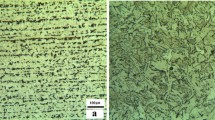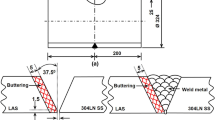Abstract
Two types of welded joints were prepared using low alloy carbon steel and austenitic stainless steel as base materials. In one variety, buttering material and weld metal were Inconel 82. In another type, buttering material and weld metal were Inconel 182. In case of Inconel 82, method of welding was GTAW. For Inconel 182, welding was done by SMAW technique. For one set of each joints after buttering, stress relief annealing was done at ~923 K (650 °C) for 90 minutes before further joining with weld metal. Microstructural investigation and sub-size in situ tensile testing in scanning electron microscope were carried out for buttered–welded and buttered–stress relieved–welded specimens. Adjacent to fusion boundary, heat-affected zone of low alloy steel consisted of ferrite–pearlite phase combination. Immediately after fusion boundary in low alloy steel side, there was increase in matrix grain size. Same trend was observed in the region of austenitic stainless steel that was close to fusion boundary between weld metal-stainless steel. Close to interface between low alloy steel-buttering material, the region contained martensite, Type-I boundary and Type-II boundary. Peak hardness was obtained close to fusion boundary between low alloy steel and buttering material. In this respect, a minimum hardness was observed within buttering material. The peak hardness was shifted toward buttering material after stress relief annealing. During tensile testing no deformation occurred within low alloy steel and failure was completely through buttering material. Crack initiated near fusion boundary between low alloy steel-buttering material for welded specimens and the same shifted away from fusion boundary for stress relieved annealed specimens. This observation was at par with the characteristics of microhardness profile. In as welded condition, joints fabricated with Inconel 82 exhibited superior bond strength than the weld produced with Inconel 182. Stress relief annealing reduced the strength of transition joints and the reduction was maximum for specimen welded with Inconel 82.















Similar content being viewed by others
References
A. Celik and A. Alsaran: Mater. Charact., 1999, vol. 43, pp. 311–18.
M. Sireesha, S.K. Albert, V. Shankar, and S. Sundaresan: J. Nucl. Mater., 2000, vol. 279, pp. 65–76.
D. Rathod, S. Aravindan, P.K. Singh, and S. Pandey: ISIJ Int., 2014, vol. 54, pp. 1866–75.
A.M. Shariatpanahi and H. Farhangi: Adv. Mater. Res., 2010, vol. 83–86, pp. 449–56.
J.W. Kim, K. Lee, J.S. Kim, and T.S. Byun: J. Nucl. Mater., 2009, vol. 384, pp. 212–21.
M. Ghosh, R. Santosh, S.K. Das, G. Das, B. Mahato, J. Korody, S. Kumar, and P.K. Singh: Metal. Mater. Trans. A., 2015, vol. 46A, pp. 3555–68.
R. Viswanathan, R.I. Jaffee, and J. Dimmer: Proceedings of Conference on Joining Dissimilar Metals, 1982.
H.P. Seifert, S. Ritter, T. Shoji, Q.J. Peng, Y. Takeda, and Z.P. Lu: J. Nucl. Mater., 2008, vol. 378, pp. 197–210.
R.D. Nicholson: Metals Technol., 1982, vol. 9, pp. 305–11.
W.K.C. Jones and P.J. Alberry: Model for stress accumulation in steels during welding. Proceedings of the Conference on Residual Stresses in Welded Construction and Their Effects, 1978.
K. Gokul Kumar, K.D. Ramkumar, and N. Arivazhagan: J. Mech. Sci. Technol., 2015, vol. 29, pp. 1039–47.
USNRC. Crack in weld area of reactor coolant system hot leg piping at VC Summer, IN00-17, October 18, 2000.
M.K. Samal, M. Seidenfuss, E. Roos, and K. Balani: Eng. Fail. Anal., 2011, vol. 18, pp. 999–1008.
J.N. Dupont and C.S. Kusko. Weld. J. N. Y., 2007, vol. 86, pp. 51–54.
R. Mittal and B.S. Sidhu: J. Mater. Process. Technol., 2015, vol. 220, pp. 76–86.
C. Jang, J. Lee, J.S. Kim, and T.E. Jin: Int. J. Press. Vessels Pip., 2008, vol. 85, pp. 635–46.
H. Ming, Z. Zhang, J. Wang, E.H. Han, and W. Ke: Mater. Charact., 2014, vol. 97, pp. 101–15.
C. Pan and Z. Zhang: Mater. Charact., 1996, vol. 36, pp. 5–10.
G. Cam, C. Yeni, S. Erim, V. Ventzke, and M. Kocak: Sci. Technol. Weld. Join., 1998, vol. 3, pp. 177–89.
G. Cam, S. Erim, C. Yeni, and M. Kocak: Weld. Res. Suppl., 1999, vol. 78, pp. 193s–201s.
G. Cam: Int. Mater. Rev., 2011, vol. 56, pp. 1–48.
D.C. Zipperian: Metallographic specimen preparation basics. http://www.metallographic.com/Technical/Basics.pdf.
J.N. DuPont, J.N. Lippold, and S.D. Kiser: Welding Metallurgy and Weldability of Ni-Base Alloys, Wiley, Hoboken, 2009, pp. 327–76 (Chap. 7).
H.S. Hosseini, M. Shamanian, and A. Kermanpur: Mater. Charact., 2011, vol. 62, pp. 425–31.
D.A. Curry: Metal Sci., 1984, vol. 18, pp. 67–76.
N. Jia, P. Eisenlohr, F. Roters, D. Raabe, and X. Zhao: Acta Mater., 2012, vol. 60, pp. 3415–34.
S. Missori and C. Koerber: Weld. J. Incl. Weld. Res. Suppl., 1997, vol. 76, pp. 125–34.
L. Yang, X. Dang, M. Li, and N. Ji: Proceedings of 2nd International Conference on Electronic and Mechanical Engineering and Information Technology (EMEIT 2012), Shenyang Liaoning, China, B. Wu, eds., Atlantis Press, Paris, pp. 697–700.
T.W. Nelson, J.C. Lippold, and M.J. Mills. Weld. J. N. Y., 1999, vol. 78, pp. 329–37.
Y.L. Shen: Scr. Mater., 1991, vol. 25, pp. 1081–85.
H. Naffakh, M. Shamanian, and F. Ashrafizadeh: J. Mater. Process. Technol., 2009, vol. 209, pp. 3628–39.
Acknowledgments
The authors are indebted to the Director, CSIR-NML for providing infrastructural facilities to carry out the investigation and providing permission to publish the work. One of the authors would also like to thank faculties of the National Institute of Technology, Tiruchirapalli, for providing valuable suggestions at various phases of the work.
Author information
Authors and Affiliations
Corresponding author
Additional information
Manuscript submitted May 2, 2016.
Rights and permissions
About this article
Cite this article
Nivas, R., Das, G., Das, S.K. et al. Effect of Stress Relief Annealing on Microstructure & Mechanical Properties of Welded Joints Between Low Alloy Carbon Steel and Stainless Steel. Metall Mater Trans A 48, 230–245 (2017). https://doi.org/10.1007/s11661-016-3840-9
Received:
Published:
Issue Date:
DOI: https://doi.org/10.1007/s11661-016-3840-9




